
SUSTAINABILITY
Sustainability is an approach, not an aesthetic
At Harford House sustainability is an overall approach, not a style or a selection of products. There are so many elements to interior design that there are no set ‘rules’ for sustainability, so I operate with the following guidelines:
Sustainability guidelines
-
Reuse
This involves assessing what clients already have, deciding which pieces will work for the project and then designing with these specific pieces in mind. These pieces could be anything from furniture, to art, rugs and textiles, or lighting. With careful planning, these items can be incorporated seamlessly and given fresh energy within a new scheme. Architecturally this can involve assessing the existing materials of a building and planning to use ‘waste’ materials from one room to furnish another. The most carbon-efficient choice is keeping and maintaining existing items, so this is our first priority in the planning stage.
-
Refinish
Some existing pieces may need to be reimagined. This includes reupholstering soft furnishings, reconditioning wooden furniture, repairing rugs, or, for example, transforming old curtains into new cushions and blinds. So much can be done when existing materials are viewed as opportunities, not limitations.
-
Reclaim
Where ‘new’ items and materials are needed, I prioritise sourcing second-hand, antique, vintage or reclaimed pieces. I have an ever-growing network of auction houses, antiques dealers, architectural salvage yards, deadstock fabric sellers and more, from whom I source unique, high-quality and environmentally-conscious pieces.
Design Values
-

Longevity
No matter how ‘eco’ an item’s credentials are, if it is not long-lasting it is not sustainable. This is why I do not follow trends. Instead, I emphasise developing a design scheme that feels absolutely authentic to the client. I consider the long-term use and adaptability of all elements of a design.
-

Health
Many household products we don’t think twice about are in fact harmful to our health. There have been, for example, concerning studies on the presence of POPs (persistent organic pollutants) in flame retardant treatments for upholstery items, and VOCs (volatile organic compounds) are found in many plastic-based paints. These products have been linked to a whole host of health concerns as well as presenting environmental problems. Harford House does not recommend finishes or products that contain these harmful chemicals; instead we recommend items that support people and planet.
-

Repair
Items break, but they should be repairable. Most pieces are no longer built with repair in mind and become obsolete as soon as they are damaged. I take repair into consideration, especially with high-traffic items like sofas, chairs, dining tables and kitchen surfaces. My aim is for items to last a minimum of 20 years, preferably longer with maintenance and repair!
-

Production
I emphasise local production, minimal transportation distances and traceable, certified raw materials and labour practices. We should know where our pieces come from and who made them.
-

Natural Materials
Using natural fibres is not only better for our wellbeing, but also better for the planet. Cotton, linen, wool, silk, sisal and jute are Harford House staples. I generally avoid synthetic materials because they are petroleum-derived and undergo chemical- and water-intensive manufacturing processes as well as often shedding microplastics. Natural fibres undergo less intensive processes and, crucially, are more recyclable and ultimately biodegradable.
-

Quality
I prioritise well-made, high-quality materials and pieces. This means, for example, looking for skilled construction of furniture pieces, favouring solid wood over composite wood, and using high rub-count fabrics, to name just a few.


